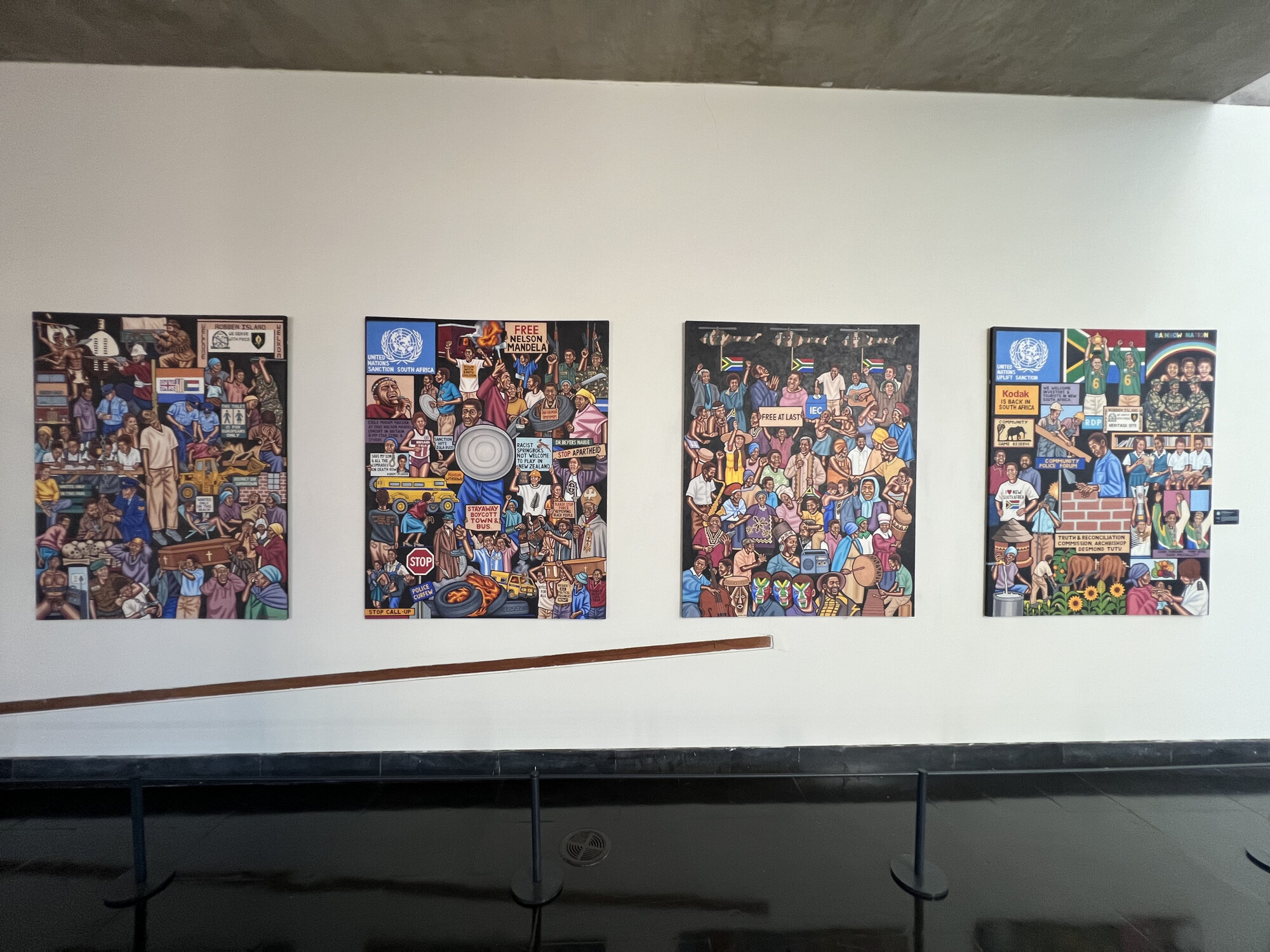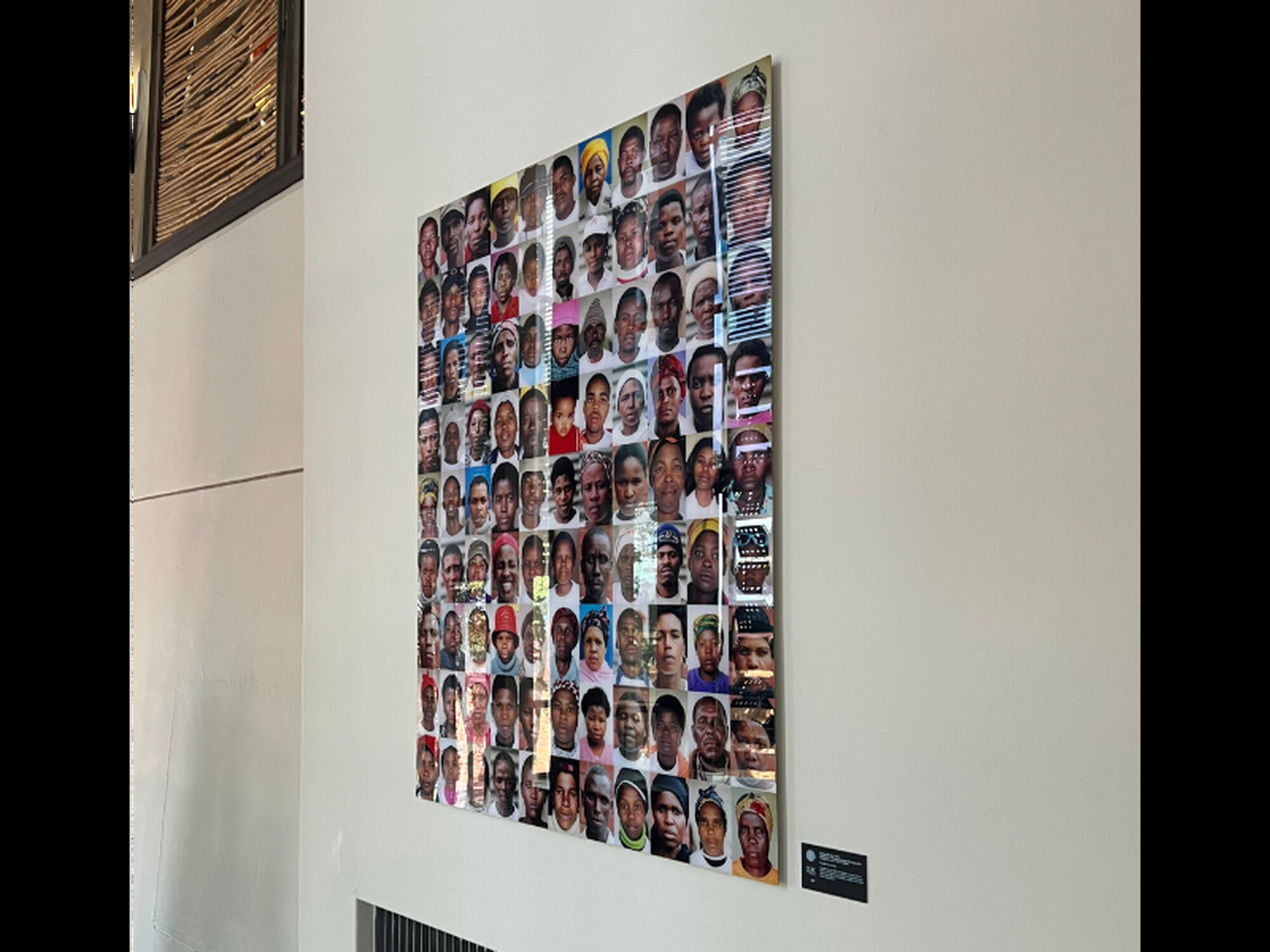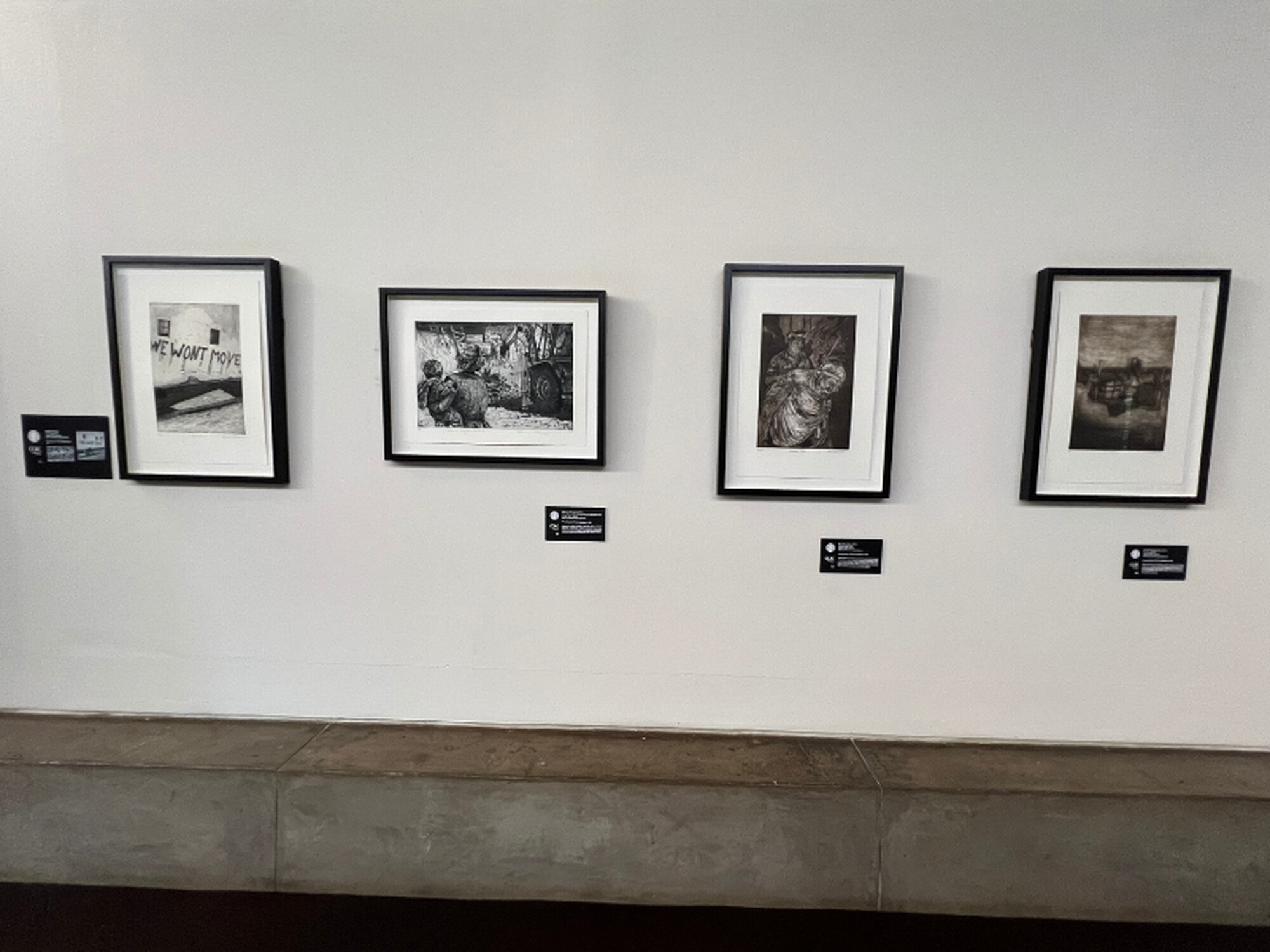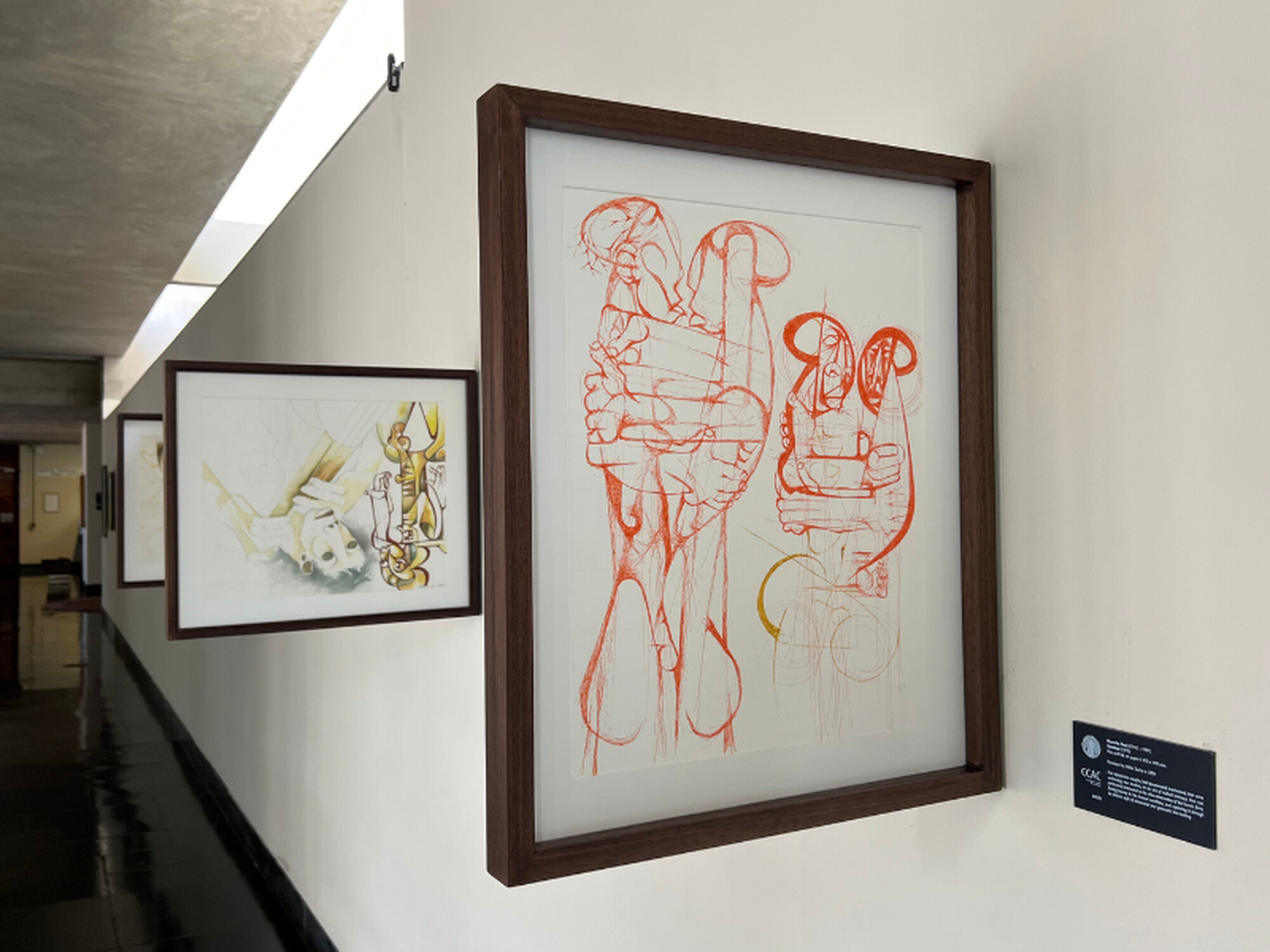Photos from our current public gallery exhibition (October 2022 - June 2023)
Date posted: 13 March 2023
In October 2022, a new exhibition was installed into the public gallery as part of our biannual rotation, showing our selection of works in the CCAC. Some of the artists featured in the exhibition include Dumile Feni, Sandile Radebe, Caesar Mkhize and Thafa Dlamini, Malangatana Ngwenya, Gille de Vlieg, Stefan Blom and Azaria Mbatha.
The exhibition explores the artists’ lived experiences of intergenerational conversations, forced removals, South African history, and the constitutional understanding of “justice under a tree”. As a body, the collection explores issues related to constitutionalism and human rights, and evokes critical engagement with these artists’ works.
The public gallery is open to the public seven days a week free of charge. Art & Justice tours are presented by the CCAC curatorial team on the second and last Saturdays of every month. More information about the tours and bookings can be found here. Descriptive signage in the gallery enables self-guided tours.
Photographs © Constitutional Court Trust.

Cecil Skotnes (1926 – 2009) and Hamilton Budaza (1958 –), Freedom (1995)
Freedom was the first artwork donated to the CCAC. Skotnes invited Budaza to collaborate on creating a tribute to democracy. The central panel by Skotes shows a figure reaching for the sky; the birds, hands and faces by Budaza similarly heralds the new dawn in 1994. It is often described as one of the CCAC’s most confident and optimistic works. In September 2022, Fine Art conservator Dr Isabelle McGinn and her Masters in Tangible Heritage Conservation students at the University of Pretoria completed the conservation treatment of the artwork. After being reframed, the artwork was re-installed in the public gallery near Georgia Papageorge’s Through the Barrier which stands in the basement of the original Awaiting Trial Block. Read more about the conservation of the artwork here.


Sipho Ndlovu (1968 –), Images of South African History 1 - 4 (c 1998).
Ndlovu’s artworks speak to distinctive periods in South Africa’s history, from the colonialism, apartheid and post-apartheid eras. The artist's intent was to show his perspective on South Africa's history in an accessible way, like you would read in a book. “Images are not like writing, a picture tells more than a thousand words,” he said.

Intergenerational Conversations: Art, Trauma, Freedom and Responsibility (2022). A Constitutional Court Trust short documentary (2022).
In 2020, Richard ‘Specs’ Ndimande (b. 1994) generously donated three portraits to the Constitutional Court Art Collection and became the youngest artist to be represented in the CCAC to date. Specs’ work represents an intergenerational conversation between himself and his father who was imprisoned in the notorious Number Four prison during apartheid. The artworks elicit conversations about the pertinent socio-political issues that “born free”youth face in post-apartheid South Africa. In 2022, the CCAC team worked with Specs to present his solo exhibition in the old Number Four prison, situated next to the Constitutional Court on Constitution Hill, responding to his dad’s incarceration there. This short documentary was produced following the opening of Specs’ solo exhibition titled Freedom & Responsibility on 16 June 2022, Youth Day, and a subsequent panel discussion held in the foyer of the Constitutional Court in September 2022, Heritage Month. Watch the documentary here.

Ceaser Mkhize (1970 –) and Thafa Dlamini (1978 –) Beaded Angels 1 - 4 (2003) and Beaded Monkey (2003).
The angels, who appear to be singing, were acquired for their jovial presence. In 1998, Mkhize partook in a doll-making workshop at Durban Art Gallery, where he began integrating beadwork, fabric and wire. Dlamini helped decorate the artworks with beads that her husband brought home from the workshop, a technique they have since continued.
The monkey might have been inspired by the character Rafiki of the animated feature film The Lion King, a sage with a deep connection to magical and spiritual elements, a trusted advisor, and his walking stick always nearby. The sculpture is a playful addition to the CCAC, intricately beaded by husband and wife duo Mkhize and Dlamini.

Gideon Mendel (1959-) Siyaphila La – We are Living Here (99 Faces) (2005).
From October 2003, the Siyaphila La (We are Living) HIV/AIDS programme improved and developed management and treatment of HIV/AIDS in Lusikisiki, a town in the Eastern Cape province, challenging related stigma in the community. Learn more about the photographic project here.

Front: Stefan Blom (1963 –) Fly By Night Girl (2015) and Dushka (2015). Back: Sue Williamson (1941 –) A Few South Africans: Jenny Curtis Schoon (1985)
Blom’s sculpture titled Fly by Night Girl looks at humanity’s fascination with flight, but also how it is used for destruction. Despite standing in what seems like a take-off stance, the female form’s clipped wings make a mockery of her ability to fly. The bombs at her feet allude to what is weighing her down – violence and oppression.
Dushka draws on the artist's experience as a conscript in the apartheid army, this work reflects on the relationship soldiers were encouraged to have with their weapons. The title refers to the 1930 Soviet machine gun, nicknamed Dushka - which is Russian for “sweetie” - an ironic term of endearment for a weapon of death and destruction.
Williamson created the series A Few South Africans in the 1980s, at a time when South Africa was still firmly in the grip of apartheid and the faces of these women seldom appeared in the press. The series attempted to make visible and to celebrate some of the women involved in the struggle for freedom. Jeanette Schoon (nee Curtis) and her husband, Marius, fled the country due to persecution for their anti-apartheid activism. In 1984, Jenny and her daughter were killed in Angola when she opened a parcel bomb sent by the security police. Her son witnessed the bombing. The perpetrators were granted amnesty by the Truth and Reconciliation Commission.

Hedwig Barry (1969 –) Crumple (Jeanette Schoon) (2021)
Barry’s sculpture was conceived as an homage to Jeanette Schoon (nee Curtis) and was installed in — 2022 for long term display. Both Williamson and Barry’s works commemorate the important yet often marginalised contributions of women to the historical struggle against apartheid and current day injustices. Barry draws inspiration from crumpled paper and the crumple zones in cars, a safety feature to protect passengers by crumpling on impact. The proportions of the sculpture suggest both an explosion and an exuberant resurrection. It recalls an act of terrible violence, but also offers hope for repair and care. The artist calls it “a feminist symbol of hope and power in violent times”.

Larry Scully (1922 – 2002), Series: Destruction of District Six (1972).
The artist documented the changing landscape of apartheid South Africa in the 1970s, taking photographs of the demolition of District Six, and the forced removal of its residents, to make way for white settlement in the centre of Cape Town. While not overtly political, Scully’s photographs capture injustices against humanity.

Commemorating Sophiatown Series by artists Simon Mthimkhulu (1967 –), Ramarutha Makoba (1984 –), Bongile Mkhize (1972 –), Nelson Makamo (1982 –) and Abe Mathabe (1959 –).

Commemorating Sophiatown Series by artists Bongane Malapane, Philemon Hlungwani (1975 –), Karen Bareuther (1977 –) and Flora Mmaphoko More (1969 –).
Sophiatown was known for being a multicultural community filled with music and dance. The series captures the lively culture within the community before it was destroyed in 1955 and rebuilt as Triomf, which became a whites-only area. The original name was reinstated in 2006. Such scenes were common in Sophiatown where music and culture were forms of resistance. Music and dance became a crucial part in the struggle against apartheid. Musicians used music and culture as forms of activism and resistance, both in South Africa and in exile, to bring hope to South Africans and to raise awareness of the atrocities committed by the apartheid regime to the rest of the world. The artworks left side of the wall represent Sophiatown before the forced removals, depicting joy and resistance. The images on the right side of the wall depict Sophiatown after forced removals, representing the mourning of the lively area.


Selected artworks by Dumile Feni (1942 – 1991).
The CCAC contains a number of double-sided artworks by Dumile Feni, as he had drawn distinct artworks onto both sides of the same paper. Feni lived in exile from the age of 26, as he was driven out of South Africa due to anti-apartheid activism. Although Feni is considered one of the great South African artists, described as the ‘Goya of the townships’, he lived in harsh poverty for most of his life and often drew on both sides of the paper due to a lack of resources and art materials. In 2022, these drawings were reframed to reveal both artworks at once, offering further insight into Feni's artistic practice and the conditions in which he worked.
Feni’s drawing shows both pain but also resilience, evoking a sombre hope for spiritual and physical liberation. Many art historians and academics agree that Feni’s works are marked by the painful histories related to violence against Black individuals and the effects of apartheid.

Left: Malangatana (1936 – 2011) O Aberto (Open) (1985). Middle: Eugenio Lemos (1930 – 1995) Untitled (Ao Grande Amigo Albie) (1989). Right: Malangatana (1936 – 2011) Luz Verde (Green Light) (1986)
Lemos, a Mozambican artist, met Albie Sachs after he moved to Mozambique in 1977, as he was banned from South Africa due to anti-apartheid activism. Sachs befriended many politically conscious artists there while he worked as a law professor and for the resistance movement abroad. Lemos later gifted this work to his "great friend Albie".
The famous Mozambican artist, Malangatana, gave this work to his friend Albie Sachs. The artwork was made two years before Sachs was the victim of a car bomb, planted by the apartheid forces in Maputo, in 1988. Sachs survived, and continued to be an admirer of Malangatana's graphic work, which came to signify resistance against violence. The artist was a highly visible political activist in the fight for independence, and is renowned worldwide for his art. The drawing shows the turmoil of the Mozambican Civil War (1977–92). Malangatana’s characteristic visual language reflects on the experience of colonialism, nationalism and conflict in his home country, Mozambique.

Sandile Radebe’s (1978 –) Voor-teruger III (2021) and Isiqhaza esizimele II (2021).
Radebe’s intervention on the Nils Anderson print, which portrays the South African landscape as vacant, seeks to locate his Zulu cultural identity that predated the painting, in a space where it was erased. Commenting on forced removals, the artist reimagines ways in which Black people existed and participate in historical records.
‘Isiqhaza’ refers to a Zulu earring and those who refused to be westernized, keeping their independence (‘esizimele’). The colours and patterns reference Zulu dress, practices, philosophy, beadwork and pottery. The sculpture responds to colonial missionaries who criticized traditional cultural beliefs in favour of a ‘civilized’ way of life.

Left: Norman Catherine (1949 –) Apocalypse (1980). Middle: Gille de Vlieg (1940 –) Meeting under a tree to discuss possible forced removal from land, Ntombi’s Camp, KwaZulu-Natal (1988). Right: Sandile Goje (1971 –) Making Democracy Work (1996)
In African legal terms, village elders gather under a tree to dispense justice. This work represents how the artist envisaged democracy, but was also central to the architectural conception of the Constitutional Court building. It speaks to the core principle of the Constitutional Court - justice under a tree.
de Vlieg was a member of the Black Sash, a human rights organization that was active in rural land struggles, and one of the few women members of the Afrapix photography collective, documenting the activist work she was involved with.
In making Apocalypse in New York, Catherine drew inspiration from the film Apocalypse Now and Pink Floyd’s album The Wall (1979). The wall and colours symbolize apartheid’s brutality, similar to Catherine’s lithograph Premonition of War. The tree evokes movement; a black hole opens up to new beginnings but also uncertainty.
Click here to see the first 3D walkthrough of the public exhibition spaces of the Constitutional Court.